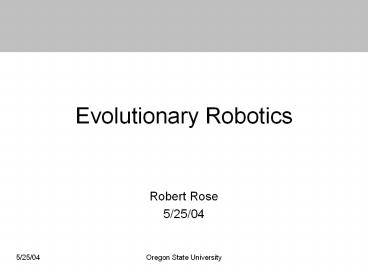Evolutionary Robotics - PowerPoint PPT Presentation
Title:
Evolutionary Robotics
Description:
Goal 2: Simulated 'robots' in animation. ... Game Theory can also be used. 5/25/04. Oregon State University. Evolving Virtual Creatures ... – PowerPoint PPT presentation
Number of Views:114
Avg rating:3.0/5.0
Title: Evolutionary Robotics
1
Evolutionary Robotics
- Robert Rose
- 5/25/04
2
Agenda
- What is evolutionary robotics?
- Why evolve robots?
- Physical simulation of robots
- Neural networks for robotics
- Evolving robot controllers
- Related work
3
What is Evolutionary Robotics?
- Evolutionary robotics is a new technique for
automatic creation of autonomous robots inspired
by the darwinian principle of selective
reproduction of the fittest. (Nolfi and Floreno) - How do you evolve a robot?
- Define a fitness function. Jumps highest,
walks farthest, etc. - Create thousands of random robots.
- Test their fitness.
- Pick the best robots, mate them to create
thousands more offspring. - Go to 3.
4
Why Evolve Robots?
- Goal 1 So youve built a robot. How do you
control it? - Many robot behaviors are too difficult to program
by hand. - If you could assist the robot by helping it
learn, you wouldnt need to program it. - Goal 2 Simulated robots in animation.
- Motion capture and keyframing can not account for
all possible desired behaviors. - Combining motion capture with physical simulation
is a black art that requires much programmer
intervention and special tuning.
5
Physical Simulation
- Physical simulation models the behavior of
physical objects in a computer. - We can simulate a real robot in a computer!
- Physical simulation provides a richer environment
if our goal is animation. - Is our goal to evolve a controller for a real
robot? - Evolving a robot controller using a physical
robot is impractical. - Simulation isnt a perfect representation of the
physical robot, but we hope its close enough.
6
Neural Networks
- NNs attempt to model the behavior of a group of
connected neurons. - A neuron may have one to many inputs.
- A neuron outputs only one value.
- A neuron uses its activation function to
determine its output value. - A common activation function is the sigmoid, but
to quickly develop more complex behavior other
activation functions can be used sum, product,
sine, absolute value, greater than, etc. (Sims
94).
7
Neural Networks for Robotics
- Two common approaches
- Each controller has its own NN
- One big NN with outputs for each controller
8
Evolutionary Robotics
- Based on Genetic Programming
- Define a chromosome format that specifies a
robot - Evolve the chromosome by generating many random
chromosomes, picking the best, mating them,
repeat.
9
Evolving Robot Controllers
- Define a fitness function
- Create many random controllers (1000)
- Test each controller, rate its fitness
- Take the best controllers (10), mate and
mutate them to create many more random
controllers - Repeat (1000 generations)
- Game Theory can also be used
10
Evolving Virtual Creatures
- Structure of robot itself is evolved
- Karl Sims, Evolving Virtual Creatures, 1994
(Karl Sims genarts.com)
11
Evorobot
- Evolve robot controller for the Khepera robot in
software. - Stefano Nolfi
- http//gral.ip.rm.cnr.it/evorobot/simulator.html
K-team.com
12
FOX
- Controller is a neural network
- Gradient descent optimization of controller
- Russell Smith, Intelligent Motion Control with
Artificial Cerebellum, 1998.
Q12.org
13
Darwin2k
- Software for evolving robot controllers
- www.darwin2k.com
Darwin2k.com
14
Demos!































